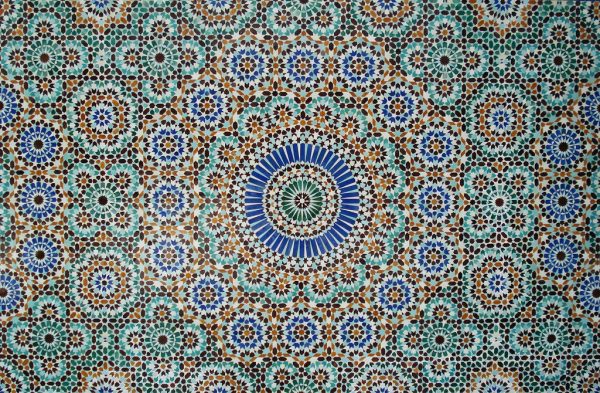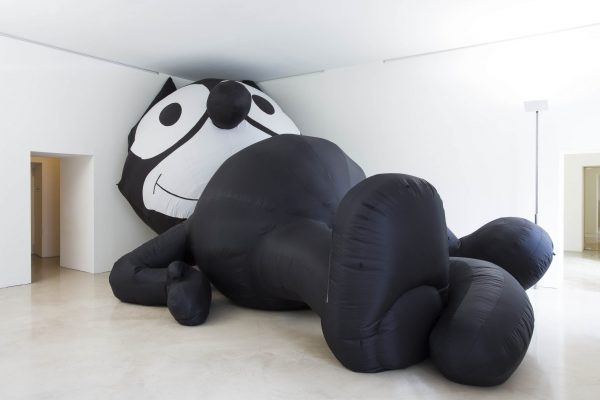A woman appears onscreen. Her hair is short. While the film is black and white, by the colour gradations I assume she is a redhead. She’s wearing sleek, cat-eye glasses and a polka-dot blouse, while holding a book as one holds a cafeteria tray. She has fair skin and delicate features; her dimples run deep. Sitting in the small, dark room screening Clayton Cubitt’s film Hysterical Literature at the Massachusetts Museum of Contemporary Art, I am both aware and unaware that today is Valentine’s Day. That is to say, more so than most holidays, if you want to you can forget this one is happening – but you’ll have to stay indoors. And we didn’t, my boyfriend and I. We’re not mentioning the day, but we’re living in it: the other couples around us, in cars, indoors – when did this happen, the fury of coupling? It began to snow moments before we left Northampton, Massachusetts, and as we watched it fall from the kitchen window we had a talk about whether or not we’d go anywhere at all, whether or not we could leave the house, which soon became a talk about what kind of people we both are without our ever saying so explicitly, and also became a call to arms against winter malaise and the circumscribed community one finds in small town New England. We’ve both been indoors so much of the last month and under the impression that little rests between our insanity and faux composure, although this isn’t true, not for us, not for most. We are, unfortunately, so much of our put together selves. And what it will really take may not seem like a lot, although it is. And so we leave; and I undergo that particular staying of the mind, which must take place, when driving in the conspiratorial quiet of new and heavy snow.
I have entered this screening space, have found myself standing before this woman – messianic as a large, disembodied torso – and this museum as I enter every exhibition: I look for some form of orientation. I look for familiar names. I look for exhibition descriptions and I hope to be surprised. I let my body follow the motion that the space exhorts it to – whichever direction the architecture propels me. Sitting in this small, dark room, at the back of the Bibliophilia exhibit, I watch a reedier and younger version of Julianne Moore smile and introduce herself.
‘Hi,’ she says. ‘My name is Stormy Leather and I will be reading American Psycho by Bret Easton Ellis.’ This woman is inarguably attractive, a universally pleasant face, taut and angular; made even more classic by the black and white film, and even more statuesque by Cubitt’s keeping step with several commercial conventions – a soft-focus lens, distinct by its redemptive qualities, and blown out lighting. It’s so dreamy, the whole scene. Stormy holds up her book and smiles charmingly, in the style of a salesperson. It works for me, she works for me, just as it is intended. That is to say, like a commercial, which operates a bit like a spider, by stunning and mesmerising its prey – they make you watch. Stormy begins to read: ‘Whitney Houston burst onto the music scene in 1985 with her self-titled LP which had four number one hit singles on it, including “The Greatest Love of All”…’
What makes a scene – a real-life one – feel like a confabulation? When does life become a dream? It is not easy to know. But it could be the four words that come before ‘life is but a dream’ in the nursery rhyme: merrily, merrily, merrily, merrily. These words are here to lull us; any word in succession is designed for that purpose, to detach itself from its etymological intentions. They are designed to distract. ‘Row, Row, Row Your Boat’ was, likely, originally created and sung by white people in blackface as part of a minstrel show, appropriating and blowing to hell African American rhetoric, song, and entertainment – all in the name of plundering, American fun. But on its surface the rhyme is entrancing, it repeats and coils, just like a dream. I don’t know; I can’t say precisely why real life begins to feel dreamy sometimes. But I can say that Stormy reading American Psycho – especially considering that it is this part, Patrick Bateman’s soliloquized review of Whitney Houston’s album, Whitney Houston – is, for me, but a horrifying dream. Bateman reviews the album with as much depth and flat lining neurotic obsession as he does his murders, while retaining his trademark clinical, capitalist savagery in his inflection. Bateman bought and killed to own. And it’s imperative as a formal literary choice, for several reasons, but it also churns because I love Whitney Houston, we love Whitney – not just in America – everyone, everywhere loves Whitney. To not is to disavow the elusive dream that Whitney represents: young, black, middle-class New Jersey girl in the gospel choir to background vocals in Chaka Khan’s ‘I’m Every Woman’ to one of pop music’s best-selling music artists of all-time. There’s feminine muscle, the tenacity white America loves to ascribe to women of colour. Whitney as Rachel – or Rachel as Whitney – in The Bodyguard tells us that someone will save us from the systems that fail us and that someone is a brooding man drinking a glass of milk alone in the dark. When I think of all the national anthems I’ve heard sung, none are as stunning as the one delivered by Whitney Houston before Super Bowl XXV in 1991 in Tampa. The hinges of her jaw seem to be double jointed, her mouth opens so wide, so casually, and it’s almost as if that sublimity puffs out from some deep, bottomless reserve, effortlessly. It’s not like most renditions of America’s national anthem, whitewashing all sporting events with the grammar of exceptionalism. It’s different. I remember watching this one on Youtube over and over several years ago. At the time I was bartending at an Oxford, Mississippi, oyster place, a year out from graduating college, terribly depressed, one foot in a consuming relationship, the other foot out, wheels spinning in mud; and as I began to set up the bar each afternoon, alone, slicing lemons and limes, I would play Whitney’s national anthem, first thing, and for just a moment, I would feel a sort of charge, a boost, a shifting of my mental state.
Stormy continues. ‘She was also cited as best new artist of the year by Billboard and by Rolling Stone magazine. With all this hype one might expect the album to be an anticlimactic…’
On this word – and this is too ironic for invention – Stormy begins, pauses, restarts and sounds it out phonetically, anti-cli-mac-tic, displaying an obvious difficulty focusing before continuing.
In the film a series of polished women of varying races, ages, professions and bodies sit at a table and attempt to read works of literature, which they’ve chosen themselves, while being distracted and stimulated underneath the table by an assistant holding a vibrator. Each new session – new woman, new text – begins with the subject and her book, a self-introduction, and ends in the same way: a repeated introduction from the woman of her person and text, immediately after her climax. This format is not only redolent of commercial-quality flourishes, but it also takes several cues from television, a highly manipulative medium. The TV series fosters an ethos of comfort and stasis by maintaining several control elements – same characters each week, theme music, etc – but subverts expectations slightly in each episode to keep you surprised, eager and ultimately, to keep you tethered. The TV series invites you to identify with its protagonists. The hours one spends watching Mad Men; they are your friends and kin and this is where your home is. We watch a show like this when we can identify with its characters, in some subliminal, aspirational way, and we begin to subtly alter our behaviours and preferences around Don Draper, Peggy Olson and Joan Harris; we want to be and conquer them.
While all sessions begin and end in the same way, utilising a ‘theme music’, each woman delivers her reading, her body and her orgasm differently; they could be broken down into categories and conscripted into psychosexual charts – the giggler, the groaner, the nonplussed – providing a taxonomy of the female orgasm by Cubbit’s directive. The camera keeps rolling for a few seconds, post-crescendo, past when the subject thinks the film has cut, so the viewer can see the laughing, the headshake, the glee, the satisfied sigh. I laugh along with them. I am in it. Somehow, it feels intimate, between each woman and myself.
But in this room I am not alone. My boyfriend is on his knees a few feet in front of me – his turquoise sweatshirt bobbing as he shifts his legs. He is also in it, laughing along with them, and scribbling notes into his notebook. I take out cashews and offer him one, but he is in an at-work posture. He is writing down everything that is happening, taking copious notes. He is laughing, too.
‘What are you doing?’ I whisper.
He holds up the notebook just a bit, as if to say, ‘This, of course.’ He is taking notes. He will use this in some way, in some work, I assume – because he is a writer – but I want him to stop. I am feeling unreasonable. This is mine, I think, but do not say to him. It is Valentine’s Day and later I’m supposed to host a Goth Love party with a group of friends, other couples, for which I’ve already laid out a black mesh shirt. I am trying to plan a party, and while I do not know it yet because of the storm setting in, I have an inkling that my plans will fail. We had trouble getting here because the snow was coming in thick curtains, and it hasn’t stopped. Instead, it has picked up, but we’ve resigned ourselves to whatever fate awaits. We may be stuck here now. And it may be in part because of this – the torrential snow – that we are able to stay here and not think of time passing. It is such a great thing, to feel patient. We are complacent, we are lolling, we are willing to ride this to nowhere.
‘We’ll pick up chips and booze on the way out,’ he says as we enter the museum, ‘just in case we get stuck.’
I am watching him write, and concurrently tuning in as each sequence ends, as each O is made with each puckered pout, and this veritable melting pot boils down to one action: the female orgasm. The hysterics – a Victorian era catchphrase for any aberrant behaviour from women, any derailment from the valued straight-faced stoicism of the time – a word which most often landed women in mental institutions, where a lobotomy, and later, shock treatment, were always on the menu.
It is also likely because of this that we are watching a succession of climaxes that we do not think how quickly this day is passing. We do not think of how we look sitting here, warm and slouched, in front of the screen. We are not becoming anything, not from this, and no one else is either – but that’s not really anyone’s fault, is it? The orgasm does not take away, nor does it make meaning. Like film, it bridges time; it creates space. Its shape is a mid-sized bubblegum bubble, small and unobtrusive, a tiny piece of tenuously portioned property between birth and death.
While viewing Cubitt’s film and smiling when the women smile, laughing when the women laugh, at all the right times, taking in Cubitt’s system of an all-relational, all-sexual, all-contextual sisterhood, I’m reminded simultaneously of a group of women I used to watch from my window and bars of soap. I ask my boyfriend if he remembers the Dove commercials.
‘You know the one,’ I whisper. ‘Hanes does the same thing, I think. Women with curves wearing their bras and towels and touching one another.’
He says that he doesn’t remember.
‘It’s just like this,’ I say to him, passing more cashews. Another woman wrought with pleasure clutches her book, grits her teeth and moans.
‘Just like this?’ He asks. I can see his eyebrows lift in the dark.
For the past decade or so Dove has been creating campaigns targeted at women, for women, selling their products alongside better body image, inclusion, oversized empathy and the universality of womanhood. I remember seeing one around two years ago of various women – all of different yet acceptable shapes and sizes appearing on camera, their shoulders bare as they wear only a white towel, as if they have just stepped out of the shower. Each takes a turn in focus, saying one word to complete the commercial’s pitch:
‘Real, beautiful, soft, smooth skin deserves to be shared, shown off, deserves to be celebrated. Join us, take a photo of your beautiful skin and add it to the gallery. Become part of Dove’s largest living ad campaign. For real women, by real women. Just like you,’ says a young African American woman with god gorgeous cheekbones. ‘And me,’ says a senior white woman with shockingly cut arms. ‘And me,’ says a perky middle-aged blonde. ‘You’ll appear in Dove ads all across America for everyone to see and love and share again.
Sisterhood as the objective identity one inherits, metastasised as commercial. A coalition of women – all in a line, grouped and linking arms – based upon normative fixed gender identities and social discourses that name and categorise. Dove shows us Everywoman as auto-inductees into Club Consanguinity. The Everywoman admires her body, needs to love her body a bit more, or is thinking undoubtedly about her body. It’s more than a glimmer of feel-good, it’s a whole tub of it, one in which she may submerge herself.
For years feminist scholars – notably Judith Butler in her most influential book, Gender Trouble – have noted the tendency to collect and generalise women, creating a singular objective identity for the feminine, and most lamentably, under the auspices of a club in which all women belong, membership gained by birth and characterised by bodily maintenance and gentleness, that which hetero normative culture espouses as expressly feminine: a tableau of tears, treadmills and touching.
Girl Gear, I’ve called it, as a way of saying that I didn’t want to be a part of it, or maybe didn’t know how to be a part of it – the utopianism of girlhood. I didn’t quite know how to touch other women without feeling that I was either taking or giving something away – holding hands, crossing arms, touching shoulders – not correctly, not with the warmth that seemed to come so easily for everyone else, not without first practising it and talking myself through it.
The year before I left Mississippi, I lived in a garage apartment hooked on to the side of a huge Victorian mansion that housed ten? twenty? fifteen? sorority women, and I became their de facto groundskeeper. All of these women were of the same age and car – nineteen, the black Pathfinder. We had a fleet of these in our driveway, up and down our street. Mornings after their parties in our shared backyard, the grass was always filled with beer cans, liquor bottles, and the detritus of a spring break in November, funnels and plastic tubes, the aftermath of a weekday Bacchanal. Of the things I found in my yard, I distinctly remember the following:
1. used tampons
2. a boy with crusted vomit, like a comet’s tail, across his cheek, sleeping on my stoop
3. a mouse, stuck to a sticky paper trap, kicking its legs to death
4. two women singing ‘Amazing Grace’ in perfect harmony, before a third walked out and, as if she had planned this, joined them and all together the ensemble finished out the song and then started again from the top, singing it once more, without ever asking one another if they wanted to give it another go
5. handfuls of the fried matter from chicken tenders, scraped off and into a pile
6. a waterlogged Chaucer reader propped up against my back door, as if they had gifted it to me, as if it was the only thing they could think to bestow upon the girl living like a troll in their backyard
7. blood, just a few drops, here and there, sprinkled out over the congregation of our yard
I watched them from my kitchen window as if it were a TV, leaning over the sink. They laughed and laughed, lived vehemently and loudly, threw their arms around each other thoughtlessly, sat in one another’s laps without being asked, slid their bodies throughout the yard and one another, draped across knees, legs spread, eating Doritos and nursing Natural Lights, their semi-toned bodies artificially tanned and tended.
The sorority women who shared my lawn, all of them touching, taking photos of one another, spilling out of that Victorian mansion in Oxford, MS. They were the chosen muses, frozen in the Villa of the Mysteries, perfectly retained by nine feet of volcanic ash, heads in laps as if laps were divans, bodies partially exposed, all of them touching, the way they would braid one another’s hair, hold hands, touch men, graze each another softly, then roughly, then softly, and talk loudly over themselves. This is how they collect, I thought, as if priming themselves for a hedonistic cult, one that overdoses on heterosexual culture. I pictured the girls frozen there, drunk, in the lawn chairs – recovered bodies in the villa after
Vesuvius erupted, preserved forever by plaster-of-paris casts made of them all, in their fallen, tender positions.




